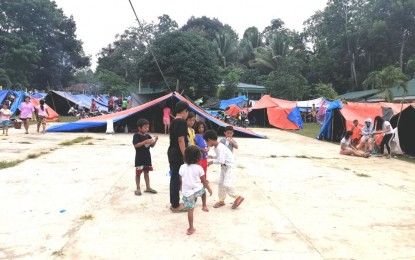
PNA file photo shows an evacuation site in North Cotabato province. Authorities in neighboring Digos City, Davao del Sur, say they are finding ways for the remaining evacuees to return home and bring back normalcy in the area.
DIGOS CITY -- The 34 evacuation centers here for earthquakes victims have now been reduced to 25 as more families return home, the City Risk Reduction and Management Council (CDRRMC) said on Friday.
CDRRMC executive officer Gil Gubat said the 34 temporary shelters were established following the series of strong earthquakes that hit the city and other parts of Mindanao on October 16, 29 and 31.
"Some of them have managed to overcome their fears and anxiety brought by the earthquakes that forced them to seek refuge in designated evacuation camps situated in different barangays of Digos City. We expect some more to follow in the next few days," Gubat said.
Gubat said some of the families that returned home had long been complaining of discomfort in their makeshift shelters and tents.
Records from the CDRRMC emergency operation center showed that more than 3,700 families or 12,000 individuals had once occupied the 34 evacuation centers.
As of November 15, he said the 25 remaining evacuation centers still host at least 9,289 people consisting of 2,389 families remain dependent on the supply of relief goods from the local government and private donors.
Mayor Josef Cagas has vowed to expedite efforts to bring back normalcy in the city, pointing out that the longer people stay in the evacuation centers, the more the possibility of vulnerable individuals such as children and senior citizens getting sick.
Vivian Ferolino, CSWDO action officer, said psychosocial interventions are continuing for families living in temporary shelters to help them cope with fear and anxiety from the recent earthquakes that traumatized many of the residents. (PNA)
